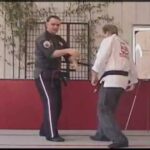
Anyone who has studied traditional martial arts for awhile has been to a seminar where the master, shaman-like, lightly hits a couple of points on the uki’s body and he goes out, caught by the faithful followers before he hits the ground. No explanation usually is offered other than the implied idea that knowledge to the secrets of the Chinese-based martial arts gave one inexplicable power.
Knowledge into the science of traditional martial arts actually does give one a certain measure of power, but it can all be explained by anatomy and physiology…and there is no magical secret to it. An attacker always believes he has the advantage: bigger, stronger, meaner, likes to fight, likes to hurt, is excited by pain, has accomplices or a weapon, is a little crazy or on drugs. Pain likely will not cause submission and just might fuel the rage. The defensive response needs to affect a subconscious reflex causing a systemic shutdown over which the aggressor has not control.
The easiest and fastest way to accomplish this is to affect a parasympathetic heart response – a specific, directed attack to the heart which causes immediate unconsciousness. Stimulating the parasympathetic nervous system causes the heart to slow down with less forceful contractions, the large arteries coming out of the heart to expand, which leads to a precipitous drop in blood pressure. The brain now cannot get enough blood so the small arteries in the brain constrict, thus decreasing blood flow to the brain further. The result: unconsciousness, called a vasovagal faint or syncope, the knockout of the seminars. This is not the same as the knockout a football player experiences on the field. That is caused by the brain being severely slammed against the cranium. This knockout is a state of temporary unconsciousness, a faint.
Points that give access to the nerves on the head and neck are able to stimulate a parasympathetic nervous system response and cause a vasovagal faint. There are two types of trauma to the body, blunt force trauma and penetrating trauma. In the traditional martial arts we have two types of strikes: blunt force trauma strikes in the traditional karate long punch; and energy penetrating strikes in the close-in fajing strike. These two strikes have different sources for their energy, although there is overlap. The fajing energy strike is especially suited to rapidly hit the vital points on the head and neck, and to send concentrated energy into the small area of the vital point.
The physics of these two kinds of strikes, as well as a complete discussion on attacking for a vasovagal knockout is discussed in the video and accompanied book, Parasympathetic Attacks to the Heart, offered by the Dragon Society International. This PATH approach is the quickest, safest and most effective means to neutralize an aggressive attack.






No comment yet, add your voice below!